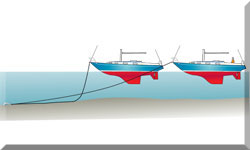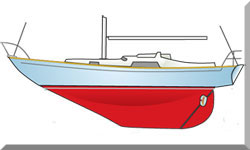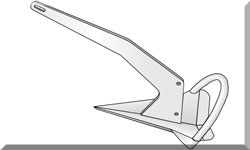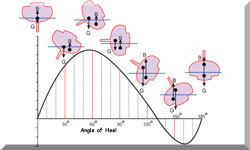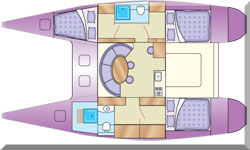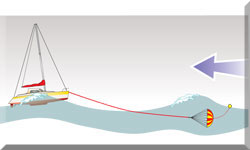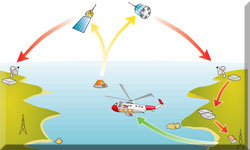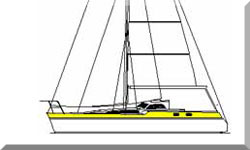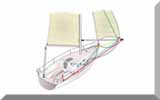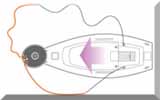- Home
- Electronics & Instrumentation
- What Is an EPIRB
What is an EPIRB?: Your Questions Answered
An EPIRB stands for Emergency Position-Indicating Radio Beacon. It is a crucial piece of safety equipment used primarily on boats and ships to signal maritime distress and alert search and rescue (SAR) authorities in the event of an emergency.
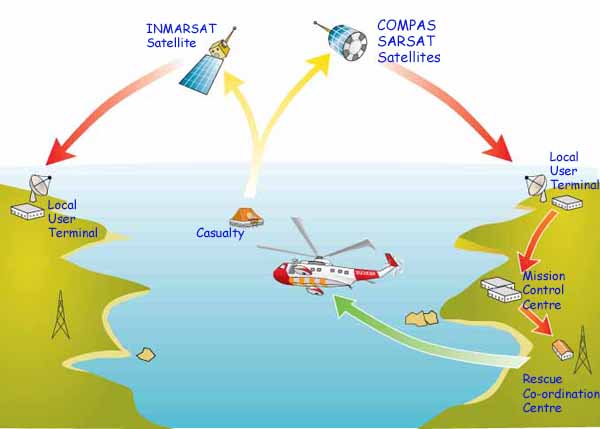 The communication channels of the marine EPIRB system
The communication channels of the marine EPIRB systemHow does an EPIRB work?
How does an EPIRB work?
An EPIRB works by transmitting a distress signal on the 406 MHz frequency to the Cospas-Sarsat satellite system. When activated (either manually or automatically upon immersion in water for float-free models), the beacon broadcasts a unique digital identification code.
This signal is detected by orbiting satellites, which then relay the information to ground receiving stations (LUTs - Local User Terminals). The LUTs process the signal to determine the beacon's identification and, if equipped with GPS or if the beacon itself has GPS capabilities, its location.
This information is then forwarded to a Mission Control Centre (MCC), which identifies the beacon's registered owner and vessel details. The MCC then alerts the appropriate Search and Rescue (SAR) authorities (MRCC - Maritime Rescue Coordination Centre) in the region of the distress.
Some EPIRBs also transmit a homing signal on the 121.5 MHz frequency, which SAR aircraft or vessels can use to pinpoint the beacon's exact location once they are in the vicinity.
GPS-equipped EPIRBs (GPIRBs) transmit their precise location data within the initial 406 MHz burst, significantly speeding up the rescue process.
What is the difference between manual and automatic (float-free) EPIRBs?
What is the difference between manual and automatic (float-free) EPIRBs?
- Manual EPIRBs: These require manual activation by the user. They typically have a button or switch that must be physically operated to initiate the distress signal. They need to be mounted in an accessible location where they can be easily retrieved in an emergency.
- Automatic (Float-Free) EPIRBs: These are designed to automatically deploy and activate if the vessel sinks. They are housed in a special bracket that is triggered by hydrostatic release unit (HRU) at a specific depth (typically around 4 meters). Once released, the EPIRB floats to the surface and automatically begins transmitting.
Most float-free EPIRBs can also be activated manually. The primary advantage of a float-free EPIRB is its ability to send a distress signal even if the crew is incapacitated or unable to reach a manually operated beacon.
Where should an EPIRB be stowed on a sailboat?
Where should an EPIRB be stowed on a sailboat?
EPIRBs should be stored in a location that is easily accessible in an emergency. Common options include mounting brackets on the deck or in a grab bag with other safety equipment like flares and torches. If the EPIRB is water-activated, it should remain in its bracket to ensure proper functionality.
What are the advantages of a GPS-enabled EPIRB (GPIRB) over non-GPS models?
What are the advantages of a GPS-enabled EPIRB (GPIRB) over non-GPS models?
The primary advantage of a GPS-enabled EPIRB (GPIRB) is the significantly improved accuracy and speed of location information provided in the distress alert.
- Faster Location Fixing: GPIRBs acquire their position from GPS satellites before or during the initial transmission. This precise latitude and longitude are encoded in the 406 MHz message, providing SAR authorities with an accurate location almost immediately upon receiving the alert.
- Increased Accuracy: Non-GPS EPIRBs rely on the Doppler shift of the satellite signal as it passes overhead to estimate the beacon's location. This process can take longer (multiple satellite passes) and is less accurate (potentially within a radius of several nautical miles).
- Reduced Search Area: The precise location from a GPIRB dramatically reduces the search area for SAR units, leading to a faster response time and increasing the chances of a successful rescue.
What frequencies do EPIRBs transmit on, and what is the purpose of each (406 MHz and 121.5 MHz)?
What frequencies do EPIRBs transmit on, and what is the purpose of each (406 MHz and 121.5 MHz)?
- 406 MHz: This is the primary distress frequency used by EPIRBs to communicate with the Cospas-Sarsat satellite system. Signals on this frequency are robust, have global coverage, and carry the digital identification code of the beacon, as well as GPS location data if the EPIRB is GPS-enabled. The 406 MHz signal is the one that triggers the alert to SAR authorities.
- 121.5 MHz: This is a secondary, lower-power homing frequency. Once SAR units are in the vicinity of the reported location, they can use direction-finding equipment to home in on the 121.5 MHz signal and pinpoint the exact location of the beacon.
While all 406 MHz EPIRBs used to transmit on 121.5 MHz, some newer models may omit this feature as SAR technology advances. However, it remains a useful backup for close-range location.
How long does it take for a distress signal to be received by search and rescue authorities?
How long does it take for a distress signal to be received by search and rescue authorities?
The time it takes for a distress signal to be received can vary depending on several factors:
- Satellite Coverage: The Cospas-Sarsat system relies on polar-orbiting satellites. The time it takes for a satellite to be in a position to detect a signal depends on its orbit and the beacon's location. It can take anywhere from a few minutes to a couple of hours for a satellite to pass overhead and detect the signal. MEOSAR (Medium Earth Orbiting Search and Rescue) systems are improving this by having more satellites in view at any given time, leading to faster detection.
- Ground Station Availability: Once a satellite detects a signal, it needs to be within range of a Local User Terminal (LUT) to download the data.
- Processing Time: There is some processing time required at the LUT and the Mission Control Centre (MCC) to decode the signal, identify the beacon, and alert the relevant Maritime Rescue Coordination Centre (MRCC).
- GPIRB vs. Non-GPS: As mentioned earlier, GPIRBs provide immediate location data, which significantly speeds up the process of alerting SAR in the correct area. Non-GPS EPIRBs require the Doppler shift calculation, which takes more time.
While it's difficult to give a precise timeframe, a signal from a GPIRB can often reach SAR authorities within minutes of activation, whereas a non-GPS EPIRB might take longer (30 minutes to a few hours) for an accurate location to be determined.
What happens after an EPIRB is activated?
What happens after an EPIRB is activated?
After an EPIRB is activated, the following sequence of events typically occurs:
- Signal Transmission: The EPIRB transmits a 406 MHz signal containing its unique identification code and, if it's a GPIRB, its GPS location.
- Satellite Detection: A Cospas-Sarsat satellite detects the signal as it passes overhead.
- Ground Station Reception: The satellite relays the signal to a nearby Local User Terminal (LUT).
- Signal Processing: The LUT processes the signal to determine the beacon's ID and location (if not GPS-equipped, location is estimated via Doppler shift).
- Mission Control Centre (MCC) Alert: The LUT forwards the information to the relevant MCC.
- Identification and Verification: The MCC uses the beacon's unique ID to access registration databases and identify the vessel owner and emergency contacts. They may attempt to verify the distress through these contacts.
- Maritime Rescue Coordination Centre (MRCC) Notification: The MCC alerts the MRCC responsible for the geographical area of the distress.
- Search and Rescue (SAR) Response: The MRCC assesses the situation and initiates a SAR operation, deploying appropriate resources (aircraft, vessels, etc.) to the reported location.
- Homing Signal: If the EPIRB transmits on 121.5 MHz, SAR units can use this signal to home in on the beacon as they approach the area.
In what scenarios should an EPIRB be activated?
In what scenarios should an EPIRB be activated?
An EPIRB should be activated ONLY in situations of grave and imminent danger to the vessel and the lives of those on board, where all other means of alerting for help have failed or are insufficient. Examples include:
- Sinking or imminent sinking of the vessel.
- Catastrophic damage to the vessel (e.g., fire, explosion, structural failure).
- A life-threatening medical emergency requiring immediate evacuation.
- Being adrift in a remote location with no means of communication.
- Any other situation where there is a high probability of loss of life if assistance is not received.
An EPIRB should not be activated for minor emergencies, equipment failures that do not pose an immediate threat to life, or as a convenience for non-emergency situations. False alarms divert valuable SAR resources and can put other lives at risk.
What is the operational lifespan of an EPIRB battery once activated?
What is the operational lifespan of an EPIRB battery once activated?
International regulations (as part of GMDSS - Global Maritime Distress and Safety System) typically require an EPIRB battery to have an operational lifespan of at least 48 hours of continuous transmission at its rated power output under specified environmental conditions.
Many modern EPIRBs exceed this requirement, often providing around 72 hours or more of operation. This extended lifespan is crucial to allow ample time for SAR units to locate and reach the distressed vessel.
How often should an EPIRB be tested?
How often should an EPIRB be tested?
It is recommended to perform a self-test of your EPIRB at least monthly. This ensures that the beacon is functioning correctly, the battery has sufficient charge, and the internal electronics are operational. Some manufacturers may recommend more frequent testing.
What is the correct procedure for performing a self-test?
What is the correct procedure for performing a self-test?
The correct procedure for a self-test can vary slightly depending on the manufacturer and model of your EPIRB. However, the general steps are usually:
- Consult the Owner's Manual: Always refer to your EPIRB's specific manual for the exact self-test procedure.
- Initiate Self-Test: Typically, this involves pressing and holding a designated "test" button for a short period (e.g., 5-10 seconds).
- Observe Indicators: During the self-test, the EPIRB will usually emit a series of visual (LED flashes) and sometimes audible signals. The sequence and color of these indicators will indicate whether the test passed or failed.
- Check Results: Refer to the manual to understand the meaning of the indicator signals. A successful test usually involves a specific pattern of flashes. A failed test may indicate a battery issue or other internal malfunction.
- Record Test: Some skippers maintain a log of their EPIRB self-tests, including the date and result.
- Important: A self-test transmits a very brief, encoded signal that is intended to be ignored by the satellite system. Do not perform a full activation as a test.
What maintenance is required for an EPIRB?
What maintenance is required for an EPIRB?
Regular maintenance is essential to ensure your EPIRB functions correctly when needed. This includes:
- Visual Inspections: Regularly check the EPIRB casing for any signs of damage, cracks, or corrosion. Ensure the antenna is intact and properly secured.
- Cleaning: Keep the EPIRB clean of salt spray, dirt, and other debris. Wipe it down with a damp cloth if necessary. Avoid using harsh chemicals.
- Mounting Bracket Check: Ensure the EPIRB is securely mounted in its bracket and that the hydrostatic release unit (if applicable) is within its service life and shows no signs of damage. For manual EPIRBs, ensure it is easily accessible.
- Lanyard Inspection: Check the condition of the lanyard (if fitted) to ensure it is not frayed or damaged.
- Self-Testing (Monthly): As mentioned previously, perform regular self-tests.
- Battery Expiry Date: Regularly check the battery expiry date marked on the EPIRB. Plan for replacement well in advance of the expiry.
- Professional Servicing: Adhere to the manufacturer's recommendations for professional servicing, especially for battery replacements and hydrostatic release unit replacements.
What is the typical service lifespan of an EPIRB battery, and when should it be replaced?
What is the typical service lifespan of an EPIRB battery, and when should it be replaced?
The typical service lifespan of an EPIRB battery is usually 5 to 10 years from the date of manufacture, depending on the manufacturer and model. This date is clearly marked on the EPIRB. The battery must be replaced by this expiry date, even if the EPIRB has never been activated.
Additionally, the battery must be replaced immediately after the EPIRB has been activated, even if the activation was brief. Battery replacement often requires sending the EPIRB to an authorized service center to ensure proper battery type, installation, and sealing to maintain water integrity.
Can the battery in an EPIRB be replaced by the owner, or does it require a certified technician?
Can the battery in an EPIRB be replaced by the owner, or does it require a certified technician?
In most cases, it is strongly recommended and often required to have the EPIRB battery replaced by a certified technician or an authorized service center. This is due to several reasons:
- Battery Type: EPIRBs require specific, high-quality lithium batteries. Using the wrong type can lead to malfunction or even safety hazards.
- Sealing and Water Integrity: EPIRBs are designed to be waterproof. Improper opening and resealing can compromise this critical feature. Certified technicians have the specialized tools and knowledge to ensure a proper seal.
- Warranty: Tampering with the EPIRB or having unauthorized battery replacement may void the manufacturer's warranty.
- Regulations: Some maritime regulations may require battery replacement to be performed by certified personnel.
While some very basic EPIRBs might have user-replaceable batteries, this is becoming increasingly rare. Always consult the owner's manual for specific instructions.
What are the indicators that an EPIRB battery needs replacement?
What are the indicators that an EPIRB battery needs replacement?
The primary indicator that an EPIRB battery needs replacement is the expiry date printed on the unit. This is a non-negotiable deadline. Other potential indicators might include:
- Failed Self-Tests: Repeated failed self-tests, especially those indicating low battery voltage, can be a sign of a weakening battery.
- Age: Even if self-tests pass, if the battery is nearing or past its stated lifespan, it should be replaced.
- Activation History: As mentioned, the battery must be replaced after any activation, regardless of duration.
Why is it crucial to register an EPIRB, and what information is required?
Why is it crucial to register an EPIRB, and what information is required?
your contact information. This allows Search and Rescue authorities to:
- Identify the Vessel in Distress: When a signal is received, the registration database provides details about the vessel, its type, size, and any other relevant information.
- Contact the Owner and Emergency Contacts: This allows SAR to verify the distress (in case of accidental activation) and gather vital information about the crew, passengers, and the vessel's intended voyage, which can significantly aid the rescue efforts.
- Avoid Unnecessary Searches: If authorities can contact the owner and confirm there is no emergency, they can avoid launching a potentially dangerous and costly search operation.
Typically required registration information includes:
- Owner's Name and Contact Information (phone number, email address).
- Vessel Name, Type, and Call Sign (if applicable).
- Vessel Identifying Marks (e.g., MMSI number).
- Emergency Contact Information (names and phone numbers of people not on board).
- Homeport and usual operating area of the vessel.
How do I register my EPIRB in my country (e.g., UK)?
How do I register my EPIRB in my country (e.g., UK)?
The process for registering an EPIRB varies by country. In the UK, EPIRBs are registered with the UK Maritime and Coastguard Agency (MCA). You can typically register online through the MCA's website. The process generally involves:
- Accessing the MCA's Beacon Registration Portal.
- Creating an account or logging in.
- Entering the unique hexadecimal identification code (UIN or Hex ID) of your EPIRB. This is usually found on the beacon itself or in its documentation.
- Providing the required information about the vessel owner, the vessel, and emergency contacts.
- Submitting the registration form.
- Keeping a record of your registration details.
It is essential to ensure your registration details are accurate and up-to-date. If you move, change your contact information, or sell your vessel, you must update the registration with the MCA.
What is the HexID or UIN of an EPIRB?
What is the HexID or UIN of an EPIRB?
The HexID or Unique Identity Number (UIN) is a 15-character alphanumeric code programmed into every 406 MHz EPIRB. It is transmitted when the beacon is activated and links the device to its registration database. This code is essential for identifying the vessel or owner during a rescue operation.
What happens if the vessel ownership changes?
What happens if the vessel ownership changes?
If the vessel ownership changes, the EPIRB registration must be updated immediately by the new owner. The previous owner should deregister the beacon. The new owner will need to go through the registration process with the relevant national authority (e.g., the MCA in the UK) and provide their own contact information and vessel details.
Failing to update the registration can severely hinder rescue efforts if the EPIRB is activated, as the contact information on file will be incorrect.
What should be done if an EPIRB is sold, lost, stolen, or destroyed?
What should be done if an EPIRB is sold, lost, stolen, or destroyed?
The owner must notify the relevant maritime authority (e.g., AMSA in Australia) to update the registration details. This prevents delays in rescue operations if the beacon is activated by a new owner or accidentally.
Are EPIRBs mandatory for certain types or sizes of vessels?
Are EPIRBs mandatory for certain types or sizes of vessels?
Yes, EPIRBs are mandatory for certain types and sizes of vessels under international regulations (GMDSS) and the national regulations of many countries. Generally, SOLAS (Safety of Life at Sea) convention requires certain commercial vessels engaged in international voyages to carry EPIRBs.
Many national regulations extend these requirements to larger recreational vessels as well, especially those operating offshore or in specific geographical areas. The specific requirements regarding the type (manual or automatic) and features (e.g., GPS) of the EPIRB may also be stipulated.
It is crucial for vessel owners to be aware of and comply with the relevant regulations in their country of registration and the areas where they operate.
What are the latest regulatory requirements for EPIRBs?
What are the latest regulatory requirements for EPIRBs?
Regulations often require EPIRBs to comply with international standards, such as having a built-in GNSS receiver for accurate positioning and transmitting on AIS frequencies. Owners should stay updated on local and international maritime safety requirements.
What should be done in case of accidental EPIRB activation?
What should be done in case of accidental EPIRB activation?
If your EPIRB is accidentally activated, it is crucial to take the following steps immediately:
- Deactivate the EPIRB: Turn off the beacon as quickly as possible according to the manufacturer's instructions.
- Contact the Relevant Authorities: Immediately contact the nearest Maritime Rescue Coordination Centre (MRCC) or Coast Guard by any means available (VHF radio, satellite phone, mobile phone).
- Provide Full Details: Inform them of the accidental activation, the time it occurred, the location, the beacon's identification number (Hex ID), and confirm that there is no actual distress.
- Follow Instructions: Follow any instructions given by the MRCC. They may ask for further information to confirm it was a false alarm.
Promptly reporting a false alarm prevents unnecessary and potentially dangerous search and rescue operations. Failure to do so can result in significant costs and penalties in some jurisdictions.
How can false alarms be prevented?
How can false alarms be prevented?
Preventing false EPIRB alarms is crucial to avoid wasting valuable Search and Rescue resources. Here are some key measures:
- Proper Stowage and Mounting: Ensure the EPIRB is securely stowed in its designated bracket to prevent accidental activation due to movement or impact. For automatic (float-free) EPIRBs, ensure the hydrostatic release unit (HRU) is correctly installed and within its service life.
- Care During Maintenance and Cleaning: Be extremely careful when working near the EPIRB to avoid inadvertently pressing the activation button.
- Educate Crew: Ensure all crew members understand how the EPIRB works, where it is located, and the importance of not tampering with it. They should also know the procedure for reporting an accidental activation.
- Careful Handling During Testing: When performing the monthly self-test, ensure you only activate the test function and do not trigger a full distress signal.
- Avoid Exposure to Water (for manual EPIRBs): Keep manual EPIRBs in a dry location unless they are designed to be waterproof even when not in their bracket.
- Regular Inspection of HRU (for automatic EPIRBs): Check the hydrostatic release unit for any signs of damage or if it is past its expiry date. A malfunctioning HRU could potentially release the EPIRB prematurely.
- Secure Lanyard: If the EPIRB has a lanyard, ensure it is stowed in a way that prevents it from accidentally snagging on something and pulling the activation pin.
What are the latest advancements in EPIRB technology?
What are the latest advancements in EPIRB technology?
Recent advancements in EPIRB technology focus on improving speed of detection, location accuracy, and providing feedback to the user. Some key developments include:
- GPS Integration (GPIRBs): As discussed earlier, this provides immediate and accurate location data in the distress alert.
- Return Link Service (RLS): This technology allows the EPIRB to receive a confirmation message back from the satellite system, indicating that the distress alert has been received. This provides reassurance to those in distress.
- Near Field Communication (NFC): Some newer EPIRBs incorporate NFC chips that allow users to interact with the beacon using a smartphone app. This can be used to check battery status, view self-test history, and access registration details.
- Improved Battery Technology: Ongoing developments in battery technology aim to increase operational lifespan and reduce size and weight.
- MEOSAR Compatibility: Modern EPIRBs are designed to work with the Medium Earth Orbiting Search and Rescue (MEOSAR) satellite system, which offers faster detection times, improved location accuracy, and enhanced reliability compared to the older LEOSAR system.
- AIS (Automatic Identification System) Integration (Hybrid Beacons): While not strictly traditional EPIRBs, some newer safety devices combine EPIRB functionality with AIS Man Overboard (MOB) features, transmitting both a satellite distress signal and a local AIS alert to nearby vessels.
What is Return Link Service (RLS) and how does it benefit the user?
What is Return Link Service (RLS) and how does it benefit the user?
Return Link Service (RLS) is a significant advancement in EPIRB technology. It provides a two-way communication capability, allowing the beacon to receive a confirmation signal back from the Cospas-Sarsat system.
When an RLS-enabled EPIRB is activated, after the distress message is received by the satellite and processed by the ground segment, a confirmation message is transmitted back to the specific EPIRB that sent the alert.
The benefits for the user are substantial:
- Reassurance: Receiving confirmation that their distress signal has been received provides vital psychological reassurance to those in a life-threatening situation. Knowing that help is on its way can significantly reduce stress and improve morale.
- Confirmation of Location Accuracy: In some RLS implementations, the return message may also confirm the location received by the authorities, further increasing confidence.
- Reduced Uncertainty: Without RLS, users have no direct way of knowing if their signal has been successfully received. RLS eliminates this uncertainty.
How does Near Field Communication (NFC) integrate with EPIRBs?
How does Near Field Communication (NFC) integrate with EPIRBs?
Near Field Communication (NFC) is a short-range wireless communication technology that allows devices to exchange data when they are 1 brought within a few centimeters of each other. In the context of EPIRBs, NFC is being integrated to provide users with a convenient way to interact with their beacons using a smartphone or other NFC-enabled device. Common applications of NFC in EPIRBs include:
- Battery Status Checks: Users can quickly check the remaining battery life of their EPIRB by holding their smartphone near the beacon.
- Self-Test History: Accessing a log of past self-tests to ensure the beacon has been regularly checked.
- Registration Details: Viewing the EPIRB's registration information to confirm it is up-to-date.
- Firmware Updates: In some advanced models, NFC might facilitate firmware updates.
- Simplified Programming: For initial setup or reprogramming, NFC could offer a more user-friendly interface.
NFC integration aims to simplify routine maintenance checks and provide users with easy access to important information about their EPIRB's status.
What is the difference between an EPIRB and a PLB (Personal Locator Beacon)?
What is the difference between an EPIRB and a PLB (Personal Locator Beacon)?
While both EPIRBs and PLBs are satellite distress beacons, they have key differences in their intended use, regulations, and features.
Intended Use:
- EPIRB (Emergency Position Indicating Radio Beacon): Primarily designed for vessel use. They are registered to a specific vessel and are intended to be activated in the event of a maritime distress situation. Many are designed to automatically activate if the vessel sinks (float-free).
- PLB (Personal Locator Beacon): Designed for individual use on land or at sea. They are registered to a specific person and are intended to be used in a life-threatening situation when the individual is away from their primary vessel or on land in a remote area.
Activation:
- EPIRB: Can be manual or automatic (float-free).
- PLB: Typically manual activation only.
Size and Portability:
- EPIRB: Generally larger and designed to be mounted on a vessel.
- PLB: Smaller and more portable, designed to be carried by an individual.
Battery Life:
- EPIRB: Must have a minimum operational battery life of 48 hours.
- PLB: Typically have a shorter operational battery life, often around 24 hours.
Registration:
- EPIRB: Registered to a specific vessel.
- PLB: Registered to a specific individual.
Regulations:
- EPIRB: Often mandated for certain classes of vessels under GMDSS and national regulations.
- PLB: Not typically mandated for vessels but are a valuable piece of personal safety equipment.
- GPS: Both EPIRBs and PLBs can be GPS-enabled.
In summary, EPIRBs are for the boat, while PLBs are for the person.
How does MEOSAR (Medium Earth Orbiting Search and Rescue) technology improve EPIRB effectiveness compared to older LEOSAR systems?
How does MEOSAR (Medium Earth Orbiting Search and Rescue) technology improve EPIRB effectiveness compared to older LEOSAR systems?
MEOSAR (Medium Earth Orbiting Search and Rescue) is a newer generation of the Cospas-Sarsat satellite system that significantly improves the effectiveness of EPIRBs compared to the older LEOSAR (Low Earth Orbiting Search and Rescue) system in several key ways:
- Faster Detection Times: MEOSAR satellites are in higher orbits and have a wider footprint, meaning more satellites are typically in view of a beacon at any given time. This significantly reduces the time it takes for a distress signal to be detected. LEOSAR satellites have a smaller footprint and longer revisit times.
- Improved Location Accuracy: MEOSAR's multi-satellite visibility allows for more accurate location determination through triangulation and trilateration, in addition to Doppler processing. This leads to a more precise initial location fix, especially for non-GPS beacons.
- Increased Signal Availability: With more satellites in view, there is a higher probability of a signal being received, even in challenging environments or with partial obstructions.
- Near-Instantaneous Detection with Galileo: The Galileo component of MEOSAR offers near-instantaneous detection capabilities in many parts of the world.
- Enhanced Reliability: The larger number of satellites in the MEOSAR constellation provides greater redundancy and system resilience.
- Return Link Service (RLS) Enablement: MEOSAR infrastructure is crucial for supporting the Return Link Service (RLS) functionality in newer EPIRBs.
In essence, MEOSAR provides a more robust, faster, and accurate distress alerting system, significantly increasing the chances of a timely and successful rescue compared to the older LEOSAR technology. Modern EPIRBs are designed to be compatible with both LEOSAR and MEOSAR systems, ensuring global coverage and leveraging the advantages of the newer technology.
Recent Articles
-
Small Boat Radar Systems: Your Questions Answered
Apr 13, 25 06:40 AM
Whatever your question about small boat radar systems, you're very likely to find the answers here... -
How a Marine EPIRB Can Get You into Trouble, As Well As Out Of It
Apr 12, 25 05:51 PM
Activating a marine EPIRB or a Personal Locator Beacon (PLB) when you're not in distress can get you in big trouble with the Coastguard, as this cautionary tale relates. -
What is an EPIRB?
Apr 12, 25 05:43 PM
Got any EPIRB-related questions? You're almost certain to find the answers here...

